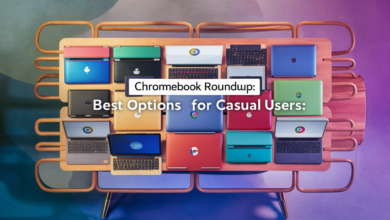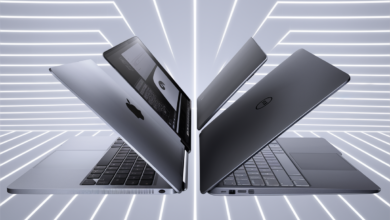Best Ultrabooks: A Comprehensive Review

Introduction to Ultrabooks
Ultrabooks have taken the tech world by storm, blending power and portability in a sleek package. For those on the go—students, professionals, or anyone who loves to travel light—the ultrabook is a game-changer. With their slim designs and impressive performance, these laptops offer everything you need without the bulk.
But what makes an ultrabook truly stand out? Is it the battery life that lasts all day? Or perhaps it’s the stunning display that brings your favorite movies to life? Whatever you’re looking for in a laptop, choosing wisely can make all the difference. In this comprehensive review of the best ultrabooks on the market today, we’ll explore essential factors to consider when making your choice.
So buckle up as we dive into top-rated models and uncover why investing in an ultrabook might just be one of your smartest decisions yet!
Factors to Consider When Choosing an Ultrabook
When selecting an ultrabook, prioritize your needs. Consider the device’s purpose. Will you be using it for work, gaming, or casual browsing? Your requirements will dictate which features are essential.
Display quality is crucial. Look for a high-resolution screen with vibrant colors and good viewing angles. A touchscreen can add versatility but might increase cost.
Battery life also matters significantly. Aim for models that offer at least 10 hours of use on a single charge to keep up with your daily tasks without frequent recharging.
Weight and portability should not be overlooked either. Ultrabooks are designed to be lightweight, making them easy to carry around.
Evaluate the performance specifications such as processor speed and RAM capacity. Ensure they align with your intended usage to avoid slowdowns during multitasking or intensive applications.
Top 5 Ultrabooks in the Market
When it comes to the best ultrabooks, a few models consistently stand out.
The Dell XPS 13 dazzles with its InfinityEdge display and sleek design. Lightweight yet powerful, it’s perfect for professionals on the go.
Next up is the Apple MacBook Air M2. With remarkable battery life and seamless integration into the Apple ecosystem, it appeals to both creatives and business users alike.
The Lenovo ThinkPad X1 Carbon combines durability with performance. Its keyboard is a dream for anyone who types extensively.
HP’s Spectre x360 offers versatility as a convertible laptop. Users appreciate its vibrant screen and solid build quality.
Consider the ASUS ZenBook 14 for its balance of power and portability without breaking the bank. Each of these ultrabooks brings something unique to enhance productivity while maintaining a stylish edge.
Comparison of Features and Prices
When diving into the world of ultrabooks, features play a crucial role in determining value. Most ultrabooks come with high-resolution displays that enhance visual clarity, making tasks like photo editing a pleasure. Touchscreen capabilities are also becoming common, adding to user interactivity.
Performance specifications vary widely among models. Some offer Intel Core i5 processors while others boast i7 or even newer chips for more demanding applications. Battery life is another key feature; many ultrabooks now promise over ten hours on a single charge.
Price points can fluctuate based on these features. Entry-level models might start around $700, while premium options can soar above $2,000 depending on added capabilities and design elements.
It’s essential to weigh what you truly need against your budget when choosing the best fit for your lifestyle and work requirements.
User Reviews and Ratings
User reviews and ratings offer a treasure trove of insights into the real-world performance of ultrabooks. Customers often share personal experiences that highlight both strengths and weaknesses.
Many users rave about the sleek designs and lightweight builds, making them perfect for on-the-go professionals. Battery life is another frequent topic; some models receive high praise for lasting all day, while others may leave users scrambling for an outlet.
Performance metrics can vary widely. Gamers might express dissatisfaction with integrated graphics, whereas business users appreciate speed in multitasking scenarios.
Customer feedback also sheds light on customer support experiences. A responsive service team can make a significant difference during ownership.
Reading user reviews provides clarity beyond technical specifications, helping potential buyers gauge what to expect from their investment in an ultrabook.
Benefits of Owning an Ultrabook
Owning an ultrabook comes with numerous advantages that enhance your computing experience. Their lightweight design makes them incredibly portable, ideal for professionals on the go or students navigating campus life.
Battery life is another standout feature. Many ultrabooks offer extended usage, allowing you to work for hours without needing a charge. This convenience means you can focus more on tasks and less on finding a power outlet.
Performance plays a crucial role too. Equipped with powerful processors and fast SSD storage, ultrabooks handle multitasking effortlessly.
Additionally, their sleek aesthetics add a touch of elegance to any workspace. With high-resolution displays and vibrant colors, content consumption becomes enjoyable—whether you’re watching movies or editing photos.
Software compatibility is rarely an issue either; most ultrabooks run popular operating systems smoothly, making them versatile for various applications and workflows.
Alternative Options for Lightweight Laptops
For those seeking alternatives to traditional ultrabooks, several options stand out. Chromebooks have gained popularity for their simplicity and affordability. They run on Chrome OS and are ideal for web-based tasks like browsing and document editing.
Another option is the 2-in-1 laptops. These devices combine the functionality of a laptop with the convenience of a tablet. The versatility makes them perfect for students or professionals who need flexibility in their work environment.
If you prefer something even more compact, consider portable mini-laptops. With screens typically under 12 inches, they prioritize portability without sacrificing performance too much.
Gaming laptops designed with lightweight builds can also serve as an alternative if you’re looking for power alongside portability. While slightly bulkier than ultrabooks, many models offer impressive specs in manageable sizes.
Conclusion: Making the Best Choice for Your Needs
When deciding on the best ultrabook for your needs, it’s essential to weigh your options carefully. Different users prioritize different features. Some may need a powerful processor for demanding tasks, while others might focus on portability and battery life.
Consider how you plan to use the ultrabook. Will it be mainly for work or casual browsing? Are you frequently traveling and require something lightweight? Understanding your primary requirements will guide your decision-making process.
Pricing is another crucial factor. The market offers a wide range of prices, with premium models featuring advanced specs that may exceed what a casual user requires. Don’t hesitate to explore various brands and configurations before settling on one.
User reviews can provide valuable insights into real-world performance and longevity of each model. Reading about other people’s experiences can help highlight potential concerns or advantages that specifications alone won’t reveal.
Owning an ultrabook brings numerous benefits: sleek design, enhanced productivity, and convenience without sacrificing power. Whether you choose one of the top five models listed or an alternative option better suited to your lifestyle, ensure it aligns with both your preferences and budget.
Take time to research thoroughly; this investment should serve you well in both personal and professional capacities for years to come. Your perfect match awaits in the world of ultrabooks.




